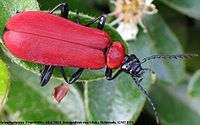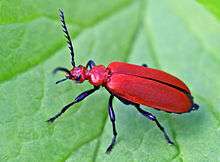Cardinal beetle
The name cardinal beetle typically refers to three different species of beetles. The red-headed or 'common' cardinal beetle (Pyrochroa serraticornis) is a red to orange beetle with, as the name suggests, a red head. It is about 20 millimetres (0.79 in) long, and is found throughout Britain.[1] The rarer black-headed cardinal beetle (P. coccinea), similarly found at sites across Britain, is larger and a deeper blood red. The scarce cardinal beetle (Schizotus pectinicornis) also has a black head, but is smaller at around 9 millimetres (0.35 in) long. The scarce cardinal is only found at a few sites in Scotland and Wales.[2]

| Cardinal beetle | |
|---|---|
 | |
| Pyrochroa serraticornis | |
| Scientific classification | |
| Kingdom: | |
| Phylum: | |
| Class: | |
| Order: | |
| Family: | |
| Genus: | |
| Species: | P. coccinea |
| Binomial name | |
| Pyrochroa coccinea Linnaeus, 1762 | |
Cardinal beetles prey on other insects, while their bright red colour prevents them being the target of other predators which believe them to be toxic.
Habitat
Red-headed cardinal beetles are normally found at the edges of woodland.[3] Adults of this variety usually emerge around May in England, when they tend to be found under loose bark on deciduous trees. Fallen and standing timber and rotting stumps may also host this species. As the weather gets warmer, they disperse and are often found on dense, low herbage.[4] They bask for long periods on large leaves often near water – the Grand Union Canal being one particular hotspot.[4]
Identification
People often mistake the smaller scarlet lily beetle, Lilioceris lilii, for a cardinal beetle as they also have a black underside and wings that are spotless and red. However, the scarlet lily leaf beetle's wing cases have tiny dimples and are shinier and more rounded than the dull, narrow, flattened and elongated cardinal beetle. The beetles can also be distinguished by the cardinal's toothed antennae.[5] Another difference between the two is their diets. Scarlet lily leaf beetles are herbivores and are usually found eating lily leaves, whereas cardinal beetles are usually found on tree bark and flowers and feed on flying insects.[6]
References
- "Cardinal Beetle". UK Safari. Retrieved 24 June 2012.
- "Cardinal Beetle - Pyrochroa coccinea". Wild About Britain. English Nature. Archived from the original on 24 December 2013. Retrieved 24 June 2013.
- "Red-headed Cardinal Beetle". The Wildlife Trusts. The Wildlife Trusts. Retrieved 24 June 2013.
- "Pyrochroa serraticornis". The Watford Coleoptera Group. Retrieved 2013-12-23.
- "UK Safari. Lily Beetles". Retrieved 2012-08-21.
- "Royal Horticultural Society. Red-headed cardinal beetle - Pyrochroa serraticornis". Retrieved 2012-08-21.
| Wikispecies has information related to Cardinal beetle |